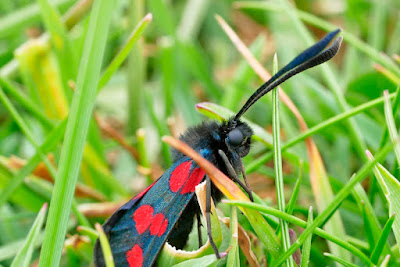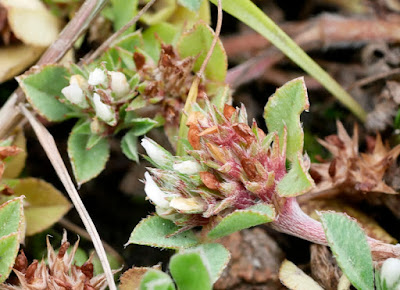June is a busy time for finding wildflowers and there's so much to see in so short a time before they go over. On our last field trip, I missed out on a few species having to leave the Cornwall Botany Group field trip a bit early, so on this day, I went to find those that I had missed and hopefully, a whole lot more.
As such, I revisited Harbour Cove, then along to Hawkins Cove and then a circular walk around Stepper Point. This had commanding views of the River Camel estuary and the coastline to the West as well. Of course, the weather wasn't playing nice and it was very windy with occasional showers.
The first species, and one I had never seen before (in flower) was Wild Leek. In Cornwall it is considered native I think, and grows in several coastal locations. I had seen these growing in several places but these were the first to 'pop' and come into flower.
In the windy conditions I had to use 1/2000th of a second to get any photos. Around three foot tall they were quite impressive.
Allium ampeloprasum var. babingtonii
As you can see, Yellow Vetch flower isn't yellow. I believe it was named from a dried up herbarium specimen in times gone by. The dried up flower had turned yellow, hence the name. The field was fenced off, so these were taken by poking the camera through the fence!
Vicia lutea
In Hawker's Cove itself, growing out of the slipway was Sea Arrowgrass, the last species I had missed on that field trip.
These don't have any petals and are exposed to salt being so close to the high tide mark.
Triglochin maritima
From here, it was a long hard slog uphill to Stepper Point. Fortunately, there were many beautiful flowers on the way up, so I could stop frequently to admire them and recover my breath.
Here are Lady's Bedstraw and English Stonecrop on a bare rocky outcrop. What a stunning colour combination.
Galium verum and Sedum anglicum
Where a streamlet crossed the path grew Watercress and this Fool's Watercress. This is one of 9 groups of flowers within the umbel. Each had around 20 individual flowers within it, so there were around 180 flowers in each head. Multipy that by all the flowers on the plant and there would have been thousands.
Heliosciadium nodiflorum
A freshly hatched Six Spot Burnet Moth, a beautiful insect awaiting some sunshine to warm it up before it can fly away. Its torpidity allowed me to get in close with the camera.
Dyer's Greenweed adorned the clifftops in swathes of yellow. This is the procumbent form (grows flat to the ground), no doubt evolved to cope with the salt laden winds blowing in from the sea. There's also a Hairy Greenweed, but somehow I managed to miss these as they flower in May and I didn't go to the right places to see it.
Genista tinctoria subsp littoralis
Sheep's Bit flowers studded the cliff turf with blue dots, but several were covered in these Sulphur Beetles, a species I hadn't seen before, but they seemed quite common here.
Cteniopus sulphureus on Jasione montana
A small disused quarry area had very thin soil which the rarer clovers like. I had a look around and found Rough Clover first.
Trifolium scabrum
Then I found some Knotted Clover, which was a nice find.
Trifolium striatum
There was much more there including Yellow-wort and Southern Marsh Orchids but I can't include everything I see. Here's the view on the way up to Stepper Point.
By the tower were numerous Musk Thistles with their top heavy flowerheads that flop over in an unmistakable fashion.
Carduus nutans
The next day, I went East to Greena Moor nature reserve to look for Wood Bitter Vetch. It was a hard slog over mostly mundane fields with high grass growth and then clambering around Purple Moor Grass mounds and boggy soil. On the way were hundreds of Meadow Thistle. I'd only ever seen these in Kenfig in Wales, so it was very nice to see them elsewhere. Only a few were in flower.
Cirsium dissectum
Bitter Vetch was surprisingly common on the culm grassland. I usually only see a few in any one area, but here there were a lot, scattered around the Purple Moor Grass tussocks.
Lathyrus linifolius
Despite a long search of the area that the Wood Bitter Vetch were found in previously, this was all I could find. None were flowering and thus wihtout flowers, they were hidden away under hordes of Bracken fronds. Either they were very late this year coming to flower or they had been previously grazed off (by deer or rabbits) and this was all that was left. Given that I found plenty in full flower at the exact same time of year in Wales a few years ago, I think they were grazed off.
Vicia orobus
On the way back was a field full of Sedges, Ragged Robin and the unusual Whorled Caraway with its unmistakable lower whorled leaves.
Trocdaris verticillata
In the car park were some Common Vetch, but they were getting on four feet tall. The flowers were dual coloured as shown below. Along with a black spot under the stipules, this confirmed it to be the fodder form of Common Vetch, quite a rare find.
Vicia sativa subspecies sativa
The rare Fen Bedstraw is present here. Unfortunately I looked in the wrong meadow for it, so all I found was the much commoner Marsh Bedstraw. They look pretty much the same, but the Fen Bedstraw is very rough to the touch and has many more prickles on the leaves and a mucro point too.
Galium palustre
Of course, there were probably hundreds of Heath Spotted Orchids present there and it's quite impossible to walk past them all and not take a photo, despite having loads of photos of them already!
Dactylorhiza maculata
So mid June draws to a close, it went so quickly! Until next time then when I finish off documenting June entirely. I hope you enjoyed the early Summer flowers.
Take Care
Dave
@botany2021




























No comments:
Post a Comment
All comments are moderated before publication, so please don't bother spamming me, thank you. Genuine comments most welcome.